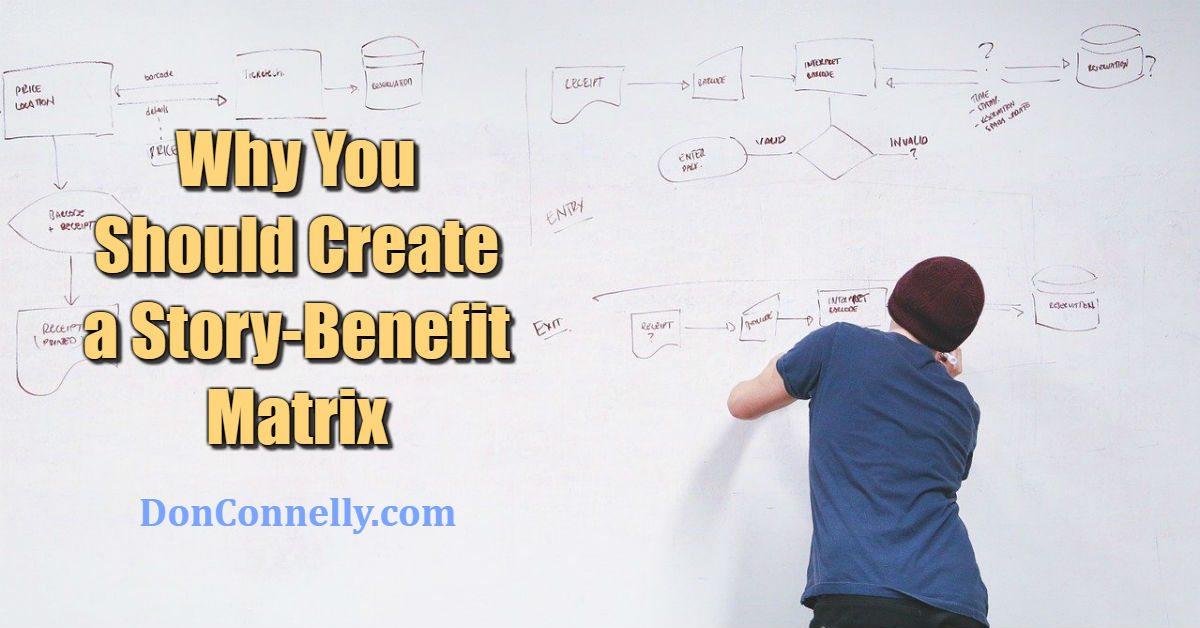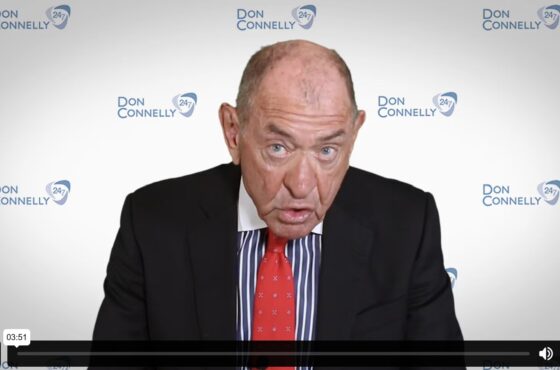Why You Should Create a Story-Benefit Matrix
 Recently, in my post ”Never Underestimate the Power of a Good ‘Who I Am’ Story,” I mentioned the concept of building a good “story-benefit” matrix. I wanted to take a little time and drill down that concept.
Recently, in my post ”Never Underestimate the Power of a Good ‘Who I Am’ Story,” I mentioned the concept of building a good “story-benefit” matrix. I wanted to take a little time and drill down that concept.
Many salespeople are familiar with the concept of a features-benefit matrix – a handy little cheat-sheet that helps sales and marketing people translate product features into benefits for the customer.
Here’s how a features-benefit matrix works in a nutshell:
Let’s say I’m a car salesman. I’m trying sell you a 2019 BMW Gran Turismo. Great car. I could memorize and regurgitate a bunch of impressive product features:
The car is 190 inches long, with a luggage capacity of 18.4 cubic feet and a payload of 919 pounds. The 3.0 liter I-6 engine generates precisely 320 horsepower with a 5,500-horsepower rpm. Oh, did I mention the front leg room is 42 inches and the rear leg room is 39.2 inches?
If a car salesman talks like this, 98% of the people walking onto the lot would fall asleep. Why? Because that’s just a mindless list of product features. There’s no connection to benefits.
People don’t care about features. When they buy the car, they aren’t buying a bucket of features. That’s not what motivates them to buy. What motivates them to buy are the benefits.
- Generous leg room means the car is comfortable even on long trips.
- There’s enough cargo space to pack skis for four people.
- The 320 horsepower means the engine is powerful enough to get your whole family up the mountain to the slopes – with their gear.
- The length means the vehicle still fits easily in most garages.
See? Every feature you bring up should be tied to one or more benefits.
It’s the same for your stories: There’s got to be a point. Each of the stories you develop should have a purpose, and that’s to convey a benefit.
Here’s why developing a story-benefit matrix is important.
#1. You make it about the client.
By tying each of your stories to a benefit to the client, you’re making it all about them – and not about you. You might start off as the subject of the story. But your story should quickly move on to how working with you benefits the client.
It’s not just the knowledge and experience you bring to the table that sells – it’s how it benefits them.
#2. You avoid boring the client.
We’ve all seen it happen: A salesperson or a boor at a party goes on and on and on about themselves. A skilled storyteller can get away with it for a while. But if you don’t eventually get around to explaining specifically how working with you benefits the client and his or her family, and how you will help them achieve their financial objectives, they’re going to tune you out. Or you’ll tell an engaging story about yourself, but you won’t close the deal.
#3. The client will retain more information.
Here’s the proof: Think of the fable “The Tortoise and the Hare.” Aesop created a valuable story about the benefits of diligence and consistency of effort and its primacy over talent alone – and all of you instantly got it when I mentioned the title.
Now, which is a more effective mode of communication: Showing the same principle at work in a math word problem or was it the story?
2500 years later, we don’t remember a math exercise. We remember the story.
#4. It leads to top-of-mind awareness.
When you connect your personal story with a benefit of working with you, you’ll create a lasting impression that is very difficult for a competitor to overcome. See, nobody can match your story. You will have indelibly connected your own unique personality and background with a solution that makes their lives better.
Maybe you don’t get the business right away. But if your story goes directly to a benefit – a real need they have – that benefit is going to be firmly attached in their minds to you, personally. It’s your story! That’s what they call top-of-mind awareness. Even if they don’t sign on today, when they’re ready to receive the benefits of doing business with you, then you’re going to be the first person they think of to call.
#5. Most importantly, it opens accounts.
The right story at the right time can and will tip the decision in your direction.
A well-timed story illustrating the logic of doing business with you has created many a client. It is a powerful way to set yourself up for the close. Tell the right story that shows how doing business with you right away is a no-brainer (in the best sense!), and you can almost see the light bulb come on over their heads. It’s fun!
And it wins business.
Your story-benefit matrix: Connecting stories to benefits
Now, if you connect each story you tell with a benefit to the client, they might think you’re an engaging, charismatic person. But they won’t necessarily mentally associate you with their desired benefit. It’s better to be thought of as boring but indelibly associated with a desired benefit than to be thought of as a nice person but not associated with a benefit at all.
So, make a list of every benefit of doing business with you. In the financial services business, an abbreviated list might look something like this:
- You can reduce market risk;
- You can improve returns;
- Their family won’t starve if the breadwinner passes away;
- You can help people pass assets on to their families more efficiently;
- You can provide a guaranteed income for life;
- They can pay their bills and accomplish financial goals if the breadwinner becomes disabled;
- You can help them reduce taxes;
- You can help reduce their vulnerability to lawsuits;
- You can help their assets keep up with inflation;
- They’ll have money to help their children or grandchildren go to college;
- You can provide better customer service so they can quickly solve problems;
Now come up with one or more illustrative stories – preferably about people you know – to drive each point home. You should also have a big repertoire of analogies you can tell to help clients understand a concept. These can be stories, too, but keep them short.
And as always, continue to develop your soft skills as an advisor. In the long run, it’s your soft-skills that will set you apart.
If you’ve been in business for five years or less and are looking for ways to kick-start your practice, watch this 4-minute video to learn how this video training program will help you.
24 video lessons. 24 exercises. A survivor’s manual. And an enormous head-start over your competition.



